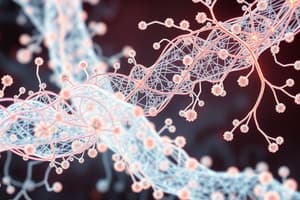Podcast
Questions and Answers
What is the primary role of myosin in muscle contraction?
What is the primary role of myosin in muscle contraction?
- Containing the actin-binding site
- Acting as the primary component of the thick filament
- Forming the thin filaments of muscle fibers
- Generating force by pulling actin towards the center of the muscle fiber (correct)
Which protein contains the actin-binding site?
Which protein contains the actin-binding site?
- Myosin (correct)
- Troponin
- Actin
- Tropomyosin
What forms the thin filaments of muscle fibers?
What forms the thin filaments of muscle fibers?
- Myosin
- Troponin
- Tropomyosin
- Actin (correct)
What is the primary component of the thick filament in muscle fibers?
What is the primary component of the thick filament in muscle fibers?
Which protein forms the primary component of the thin filament?
Which protein forms the primary component of the thin filament?
During muscle contraction, what does myosin bind to, causing movement?
During muscle contraction, what does myosin bind to, causing movement?
What is the role of troponin C in muscle contraction?
What is the role of troponin C in muscle contraction?
What is the function of tropomyosin when calcium levels are low?
What is the function of tropomyosin when calcium levels are low?
Which protein complex plays a crucial role in muscle contraction?
Which protein complex plays a crucial role in muscle contraction?
What happens when calcium levels rise in muscle contraction?
What happens when calcium levels rise in muscle contraction?
What is the role of troponin I in muscle contraction?
What is the role of troponin I in muscle contraction?
What component helps regulate the interaction between actin and myosin?
What component helps regulate the interaction between actin and myosin?
What is the function of tropomyosin when calcium levels rise?
What is the function of tropomyosin when calcium levels rise?
What happens when tropomyosin blocks the myosin-binding sites on actin?
What happens when tropomyosin blocks the myosin-binding sites on actin?
What is the function of troponin T in muscle contraction?
What is the function of troponin T in muscle contraction?
What does the sliding filament theory explain?
What does the sliding filament theory explain?
Study Notes
Sliding Filament Theory: Understanding Muscle Contraction
The sliding filament theory explains how muscle fibers produce force to facilitate movement. This theory states that muscles contract when two filaments, actin and myosin, slide past each other. In this article, we will delve into the intricacies of the sliding filament theory, focusing on muscle contraction, myosin, actin, troponin, and tropomyosin.
Muscle Contraction
Muscle contraction occurs when the muscle shortens, generating force to produce movement. This process involves the interaction of actin and myosin filaments. When a muscle contracts, it shortens, generating force to produce movement. The force that a contracting muscle generates is a result of the movement of actin and myosin filaments.
Myosin
Myosin is a protein that plays a crucial role in muscle contraction. It is the primary component of the thick filament and contains a long, flexible tail and a short, bulky head. The myosin head contains the ATP-binding site and the actin-binding site. During muscle contraction, the myosin head binds to actin, pulling it towards the center of the muscle fiber.
Actin
Actin is a protein that forms the thin filaments of muscle fibers. It is the primary component of the thin filament and contains the actin-binding site. During muscle contraction, the myosin head binds to actin, pulling it towards the center of the muscle fiber. The actin filament slides past the myosin filament, causing the muscle to shorten and generate force.
Troponin
Troponin is a protein complex that plays a crucial role in muscle contraction. It is composed of three subunits: troponin C, troponin I, and troponin T. Troponin C is responsible for binding to calcium ions, while troponin I inhibits the interaction between actin and myosin when calcium levels are low. When calcium levels rise, troponin C binds to calcium ions, releasing troponin I, allowing actin and myosin to interact and facilitating muscle contraction.
Tropomyosin
Tropomyosin is a protein that helps regulate the interaction between actin and myosin. It is a long, thin protein that lies on the surface of the actin filament. When calcium levels are low, tropomyosin blocks the myosin-binding sites on actin, preventing muscle contraction. When calcium levels rise, tropomyosin moves away from the myosin-binding sites, allowing actin and myosin to interact and facilitating muscle contraction.
In summary, the sliding filament theory explains how muscle fibers produce force to facilitate movement. This process involves the interaction of actin and myosin filaments, with the help of troponin and tropomyosin. By understanding these components and their interactions, we can gain a deeper understanding of muscle contraction and its role in movement.
Studying That Suits You
Use AI to generate personalized quizzes and flashcards to suit your learning preferences.
Description
Test your knowledge of the sliding filament theory and muscle contraction with this quiz. Explore concepts such as actin, myosin, troponin, and tropomyosin, and gain a deeper understanding of how muscle fibers produce force to facilitate movement.




